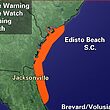Get ready for some good eating in South Carolina it’s shrimp season.
According to the South Carolina Department of Natural Resources, shrimp-baiting season opened Sept. 14 for 60 days. That means recreational shrimpers may cast nests for shrimp over bait throughout the season, as long as they purchase a license from DNR.
Aside from the shrimping done by commercial fisherman on the island, much of the shrimping is done by vacationers and laymen looking for a little adventure out in the water.
The best time to go out shrimping is at dusk and during low tide. Be sure to check tide charts to make sure that the two line up or you could head out to one of Edisto’s many creeks only to find that the water is almost covering the tops of the marsh grass thanks to high tide.
Cast the net in an area where it is unlikely to become tangled with anything else. Keep an eye out for buoys, channel markers, long-forgotten posts from old docks, and anything that could potentially snag or snarl the net.
Shrimp nets, once cast, sink thanks to the weights that are attached to it, so it is best to cast in an area that is chest-deep or shallower.
Once the net settles on the bottom, use the rope attached to it and pull it to gather shrimp. The net will close in around itself to capture what’s inside. When the catch comes to the surface, take the net to an area where the net settles on the bottom, use the rope attached to it and pull it to gather shrimp. The net will close in around itself to capture what’s inside. When the catch comes to the surface, dump it into a wide-rimmed bucket.
Dumping the catch has always been my favorite part about shrimping. While most people are pleased to see the shrimp in the net, I’ve always enjoyed looking at everything else that comes up with it. For the most part all that comes up is mud, crabs, and fish, but every now and again something that has no place in the waterways comes up.
Toss any shrimp in a cooler filled with ice and then repeat the process of casting the net until you catch your fill. Note that if any shrimp have black eggs under its abdomen it is a pregnant female and should be thrown back.
To clean the shrimp, run them under fresh water and remove the heads, tails, shells and legs. Some people also de-vein the shrimp, but that is a matter of a preference. Be careful cleaning the shrimp; the horns on the head are sharp and you don’t want to prick yourself with a dirty shrimp.
Once the shrimp are clean, prepare them in whatever fashion you desire for a home-cooked seafood meal.






